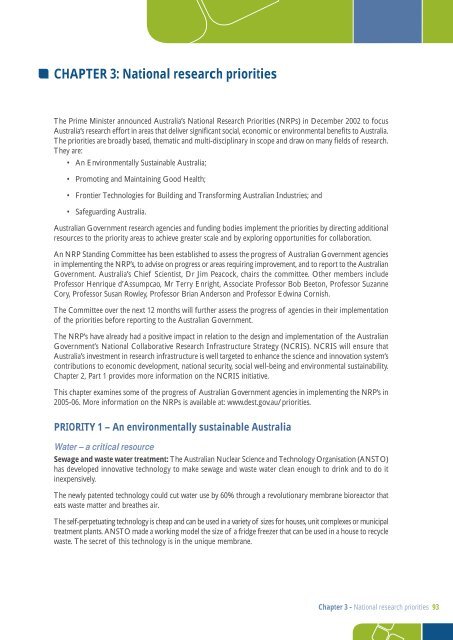The Australian Government's Innovation Report
The Australian Government's Innovation Report
The Australian Government's Innovation Report
You also want an ePaper? Increase the reach of your titles
YUMPU automatically turns print PDFs into web optimized ePapers that Google loves.
CHAPTER 3: National research priorities<br />
<strong>The</strong> Prime Minister announced Australia’s National Research Priorities (NRPs) in December 2002 to focus<br />
Australia’s research effort in areas that deliver significant social, economic or environmental benefits to Australia.<br />
<strong>The</strong> priorities are broadly based, thematic and multi-disciplinary in scope and draw on many fields of research.<br />
<strong>The</strong>y are:<br />
• An Environmentally Sustainable Australia;<br />
• Promoting and Maintaining Good Health;<br />
• Frontier Technologies for Building and Transforming <strong>Australian</strong> Industries; and<br />
• Safeguarding Australia.<br />
<strong>Australian</strong> Government research agencies and funding bodies implement the priorities by directing additional<br />
resources to the priority areas to achieve greater scale and by exploring opportunities for collaboration.<br />
An NRP Standing Committee has been established to assess the progress of <strong>Australian</strong> Government agencies<br />
in implementing the NRP’s, to advise on progress or areas requiring improvement, and to report to the <strong>Australian</strong><br />
Government. Australia’s Chief Scientist, Dr Jim Peacock, chairs the committee. Other members include<br />
Professor Henrique d’Assumpcao, Mr Terry Enright, Associate Professor Bob Beeton, Professor Suzanne<br />
Cory, Professor Susan Rowley, Professor Brian Anderson and Professor Edwina Cornish.<br />
<strong>The</strong> Committee over the next 12 months will further assess the progress of agencies in their implementation<br />
of the priorities before reporting to the <strong>Australian</strong> Government.<br />
<strong>The</strong> NRP’s have already had a positive impact in relation to the design and implementation of the <strong>Australian</strong><br />
Government’s National Collaborative Research Infrastructure Strategy (NCRIS). NCRIS will ensure that<br />
Australia’s investment in research infrastructure is well targeted to enhance the science and innovation system’s<br />
contributions to economic development, national security, social well-being and environmental sustainability.<br />
Chapter 2, Part 1 provides more information on the NCRIS initiative.<br />
This chapter examines some of the progress of <strong>Australian</strong> Government agencies in implementing the NRP’s in<br />
2005-06. More information on the NRPs is available at: www.dest.gov.au/priorities.<br />
PRIORITY 1 – An environmentally sustainable Australia<br />
Water – a critical resource<br />
Sewage and waste water treatment: <strong>The</strong> <strong>Australian</strong> Nuclear Science and Technology Organisation (ANSTO)<br />
has developed innovative technology to make sewage and waste water clean enough to drink and to do it<br />
inexpensively.<br />
<strong>The</strong> newly patented technology could cut water use by 60% through a revolutionary membrane bioreactor that<br />
eats waste matter and breathes air.<br />
<strong>The</strong> self-perpetuating technology is cheap and can be used in a variety of sizes for houses, unit complexes or municipal<br />
treatment plants. ANSTO made a working model the size of a fridge freezer that can be used in a house to recycle<br />
waste. <strong>The</strong> secret of this technology is in the unique membrane.<br />
Chapter 3 - National research priorities 93












![[Tam] Uygula[ya] - Bilim, Teknoloji ve Ä°novasyon Politikaları TartıÅma ...](https://img.yumpu.com/36820041/1/184x260/tam-uygulaya-bilim-teknoloji-ve-anovasyon-politikalara-tartaama-.jpg?quality=85)



